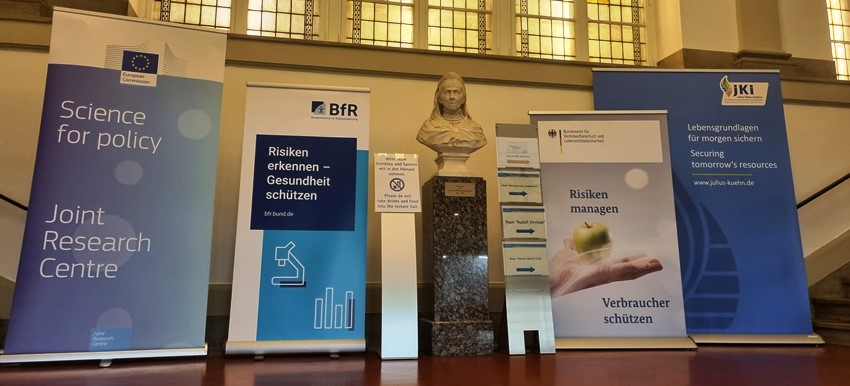"Times are changing and we are changing with them."
This sentence characterised the "International Conference on GMO Analysis and New Genomic Techniques", which took place from 14 to 16 March 2023 in Berlin.
In 2008, the "1st Global Conference on GMO Analysis" took place in Italy. 15 years later, new trends and developments required an update of the scientific exchange within the international community dealing with the detection of genetically modified organisms. AGROLAB LUFA was represented by two scientists on site to learn about current developments.
The conference was jointly organised by the Federal Ministry of Food and Agriculture (BMEL), the Federal Institute for Risk Assessment (BfR), the Federal Office of Consumer Protection and Food Safety (BVL), the Julius Kühn Institute (JKI) as well as the Joint Research Centre of the EU Commission (EU-JRC) and the Secretariat of the United Nations Convention on Biological Diversity (SCBD).
More than 450 scientists (200 on site and over 250 online) discussed current developments in the field of detection of genetically modified organisms (GMOs). It quickly became clear that the new genome techniques (NGT) in particular represent an enormous challenge for analytics. The new "genome editing" methods include CRISPR/Cas, zinc finger nuclease techniques, TALEN (Transcription Activator-like Effect Nuclease) and oligonucleotide-directed mutagenesis (ODM).
In the EU, both conventionally produced GM plants and products produced using the new genomic techniques are subject to authorisation and labelling requirements. There are efforts to relax these legal restrictions.
Control laboratories check compliance with the European requirements. For this purpose, accredited procedures must be available with which genetic modifications in products can be reliably detected. The detection of typical screening elements found in conventionally produced GM plants or event-specific PCR methods are among the routine procedures with which a large number of GM plants can be identified and usually also quantified. However, difficulties arise with GMOs produced using new genome techniques. Here, in some cases, only individual DNA bases are changed, which can also happen in classical breeding methods through natural mutation. Legally secure proof of genetic manipulation has therefore not been possible in most cases to date.
Against this background, further developments of the previous PCR methods as well as "Next Generation Sequencing" (NGS) were discussed. However, the effort required for method development is very high in order to obtain sufficient sequence data with which a single genome alteration can be reliably detected. The way in which this has arisen, whether classically or through the new genetic engineering, cannot be answered analytically at present.
However, there are also genome alterations that lead to larger DNA base deletions (i.e. to the loss of several nucleic acid building blocks in the original genome). In these cases, it is very unlikely to be a natural mutation, such as in the case of the soybean Calyxt®, a soybean produced with the help of new genetic engineering.
The BVL presented a detection method for this GM soybean, but it was only "cold validated". This means that no original plant material was available as a reference. The detection could only be developed using researched, theoretical sequence data. Thus, it was exemplarily shown that genome alterations can be detected by the new genome techniques in certain cases. However, the conclusion from this paper is that the analytical detectability of the modification must be assessed individually for each new GMO product produced with new genome techniques.
Lack of reference materials and incomplete sequence data make it difficult for monitoring authorities to develop specific detection methods, not to mention the high costs involved. For the time being, these methods will not be available for analytical routine. The planned amendment of European genetic engineering law therefore rightly remains controversial in this respect as well.
YOUR PLUS: AGROLAB LUFA is continuously expanding its range of detection and quantification methods for GM plants in food and feed and continues to pursue the development of new methods with regard to their suitability for routine use, among other things by participating in international expert symposia.
Author: Anja Palisch (AGROLAB LUFA)

 LinkedIn
LinkedIn ALOOSTA
ALOOSTA Contact
Contact
 Contact
Contact Career
Career